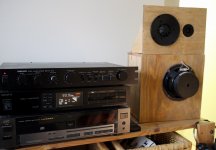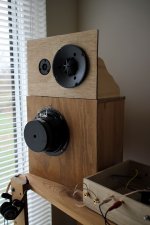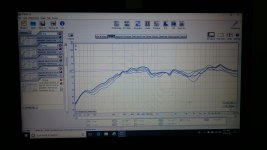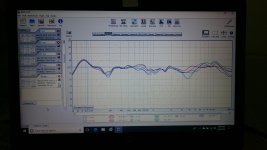Hello,
When I was sorting out the electrical part of the powered speakers and subwoofer I'm going to build I turned out to not need a couple of components I was first planning to use, this saved me quite some money. You would think: "well, nice little safe." but I would save so much money I kinda felt bad to not improve the speakers even further. So I just put together a few alternative designs together like making towers with two woofers in stead of bookshelfs with just one but none of them would be a good choice because I actually don't really want towers for my listening room and I want to use PRs but the towers would take so much PRs it would be just a little over the budget.
So I want to stay with my bookshelfs but I still want to do something to make them better. I know about the isobaric principle and adding another woofer and then putting both woofers in parallel would still fit in the capabilities of the amp, so I would love to make the bookshelfs isobaric.
So the isobaric should be good at reducing distortion and make the woofers move and so sound even quicker and better in control because of the doubled motor.
But I read about a couple of parameters changing.
In parallel the sensitivity of both woofers combined and the max output in db stays the same right? But the vas changes, and a couple of other things.
So the main question is: Can I use isobaric woofers in the same, previously not isobaric, enclosure design. So the same volume, tuning of the PRs etc. Only one of the woofers is radiating in the enclosure so should be right?
When I was sorting out the electrical part of the powered speakers and subwoofer I'm going to build I turned out to not need a couple of components I was first planning to use, this saved me quite some money. You would think: "well, nice little safe." but I would save so much money I kinda felt bad to not improve the speakers even further. So I just put together a few alternative designs together like making towers with two woofers in stead of bookshelfs with just one but none of them would be a good choice because I actually don't really want towers for my listening room and I want to use PRs but the towers would take so much PRs it would be just a little over the budget.
So I want to stay with my bookshelfs but I still want to do something to make them better. I know about the isobaric principle and adding another woofer and then putting both woofers in parallel would still fit in the capabilities of the amp, so I would love to make the bookshelfs isobaric.
So the isobaric should be good at reducing distortion and make the woofers move and so sound even quicker and better in control because of the doubled motor.
But I read about a couple of parameters changing.
In parallel the sensitivity of both woofers combined and the max output in db stays the same right? But the vas changes, and a couple of other things.
So the main question is: Can I use isobaric woofers in the same, previously not isobaric, enclosure design. So the same volume, tuning of the PRs etc. Only one of the woofers is radiating in the enclosure so should be right?
First thing, if you already have the enclosures built, then it would at best make it look like 2x the volume, but less so in reality, because you'll be eating a good deal of that volume with the coupling arrangement. Second, would this apparent increase in Vb be beneficial to the woofer and alignment in question? It was (most likely) not taken into account in the original design after all and would be a significant enough deviation IMO.
As far as sensitivity goes, parallel woofers will be the same as a single, but efficiency will be down 6dB, just make sure you have the amplifier power for it.
You'd also want to make sure to install the interior driver as close as you can to the exterior one and low-pass it at a frequency lower than a quarter-wavelength of the cone-to-cone distance.
All in all, I'd say it's not worth it as an afterthought and, even when planned ahead, all it really does is to essentially halve a single driver's Vas and thus resulting Vb.
As far as sensitivity goes, parallel woofers will be the same as a single, but efficiency will be down 6dB, just make sure you have the amplifier power for it.
You'd also want to make sure to install the interior driver as close as you can to the exterior one and low-pass it at a frequency lower than a quarter-wavelength of the cone-to-cone distance.
All in all, I'd say it's not worth it as an afterthought and, even when planned ahead, all it really does is to essentially halve a single driver's Vas and thus resulting Vb.
Isobaric arrangement requires half the volume of a single driver, that's about it, very minimal reduction in distortion, in fact if you use the two drivers normally the distortion will be less due to less excursion
There is another mode of distortion reduction by using clam arangement, when one driver eliminates some distortion of the other.
Where are you XOing? At a frequency related to the half-wave of the distance from the inside of the baffle to the front odf th erear baffle you start getting significant ripple. You would want to XO wellbelow that… usually not possible with the typical cone + dome speaker.
dave
dave
I’ll give some more details,
I’m using the Dayton Audio ES180Ti-8 woofer, NOT TiA, Ti! And a Fountek NeoX1.0 ribbon tweeter. The amplifier I’m gonna be using is the Hifimediy T3S with Jantzen caps which has more than enough power to drive the woofers, 2x150 watts RMS @ 8 ohm, 2x300 watts RMS @ 4 ohm. And as far as the flexibility of the crossover goes I’m not limited because I’m gonna be bi amping via a MiniDSP 2x4 HD.
The enclosure haven’t been build yet, what I mean with the same design is pretty much keeping the current design but just with a second baffle on the inside.
But as I understand. If I first were to make the Vb 20 L I would now only need 10 L?
I’m using the Dayton Audio ES180Ti-8 woofer, NOT TiA, Ti! And a Fountek NeoX1.0 ribbon tweeter. The amplifier I’m gonna be using is the Hifimediy T3S with Jantzen caps which has more than enough power to drive the woofers, 2x150 watts RMS @ 8 ohm, 2x300 watts RMS @ 4 ohm. And as far as the flexibility of the crossover goes I’m not limited because I’m gonna be bi amping via a MiniDSP 2x4 HD.
The enclosure haven’t been build yet, what I mean with the same design is pretty much keeping the current design but just with a second baffle on the inside.
But as I understand. If I first were to make the Vb 20 L I would now only need 10 L?
Because the centre of the speaker ( woofer ) is not allowed to emit nor heard due to the magnet being in front of it, and also the basket.Not to mention simpler crossover...guess why?
Is the center that emits the treble 'cos it has no added mass represented by the surrounding area of the cone, that flexes and doesn't respond quickly to the solicitation of the MVC ( moving voice coil !! ).
Still, no good excuse for not filtering...OR...the woofer in that situation didn't present any noticeable break-up.
Yeah, was to expensive to build and hard to come by but these speakers are gonna be made out of polyester/fibreglass so this should also be very interesting.
So as I can tell of all your reactions I guess it won’t have that much of an advantage and is just unnecessarily making the build more complicated so I think i’ll just keep it at a single woofer. I just realised, I can also buy a nice Aune C7S to drive my HD650, really really want and need a good headphone amp actually.
Thanks for the advice...
Thanks for the advice...
The real is thing is that the VAS is halved.Isobaric arrangement requires half the volume of a single driver,
The reduction of distortion supposes that the drivers are mounted face to face, when one cone is pushed, the other is pulled.that's about it, very minimal reduction in distortion, in fact if you use the two drivers normally the distortion will be less due to less excursion
It reduces even order non-linear distortion (2nd order, 4th order etc) because even order distortion is described by a transfer function which is not symmetrical - e.g. the cone moves further outward from the resting position than inward when reproducing a sine wave.There is another mode of distortion reduction by using clam arangement, when one driver eliminates some distortion of the other.
Placing two woofers magnet-to-magnet or face-to-face in a sealed chamber achieves a symmetrical transfer function because the asymmetry from one woofer opposes the asymmetry of the other woofer. This lead to (at least partial) cancellation of even order non-linear distortion components.
The same effect can be achieved for a non-isobaric speaker that has two woofers. Just mount one of them magnet-out on the baffle.
Just running two woofers in a non-isobaric config achieves lower distortion of all orders because the transfer functions tend to be more linear through a smaller excursion. If you have two woofers on a baffle, they only need half the amount of excursion to reach the same sound level as a single woofer or isobaric config.
The main motivation for isobaric is that the enclosure can be half the size. This can allow a very low F3 in a small enclosure.
Last edited:
I already know what I'm gonna do, no isobaric. I'm gonna upgrade my source, a Shiit Jotunheim with a Google Chromecast Audio for wireless instead of a Yamaha WXC-50. Than I have something amazing to drive my headphones with as well and the Yamaha had some tech built in which supposedly "enhances" the signal which I don't really trust. It's just messing around with the signal and filling up the gaps with fake sounds and even if it really worked beneficially I still just want a pure signal, which I'm definitely gonna get from the Jotunheim.
And maybe, maybe I might take a look at the idea of the aluminum enclosure because it still tickles of excitement.
Where are you XOing? At a frequency related to the half-wave of the distance from the inside of the baffle to the front odf th erear baffle you start getting significant ripple. You would want to XO wellbelow that… usually not possible with the typical cone + dome speaker.
dave
Hi dave, sorry for not replying sooner. I was hoping to find old holm files when i was optimizing crossover. They are probably gone with old dead laptop.
Anyway, crossover frequencies are 900Hz and 4000Hz. The usuall. I have read your comment about half-wave distance in many threads. Not sure if its applicable. First, my on and of axis measurements do not show any such thing. Second, many hiend commercial speakers clearly do not follow that rule. That itself does not make them right, but measurements by stereophile do not show they have of axis problem either.
So today i remeasured little 3way bookshelf. Without the sub. Right there on the shelf. Looks ok to me. Sounds great actually.
Attachments
Here is complete with the sub. Looks ok to me, no of axis problem, contrary to what you expected.
Minor dip i see ~4000, perhaps due to horizontal placement of the domes. But this has nothing to do with isobaric you objected to. Yes, placement is not ideal.
Minor dip i see ~4000, perhaps due to horizontal placement of the domes. But this has nothing to do with isobaric you objected to. Yes, placement is not ideal.
Attachments
OP is only 15 years old!!!
Quoting from an earlier thread of OP's:
I’m only a 15 y/o but the enclosure design is seriously good, maybe even amazing. This project started out about 1-1/2 year ago and since I have continuously been learning about, designing and working with speakers and it has already become a, maybe a little to extreme of an obsession.
But to come back to business, isn’t 1/4” a little thin? And what do you mean with “lined with butyl + foam”? What’s butyl, what kind of foam and what do you mean with lining? Probably a stupid question but I’m from the Netherlands and my English is good but not that good ����*♂️.
Quoting from an earlier thread of OP's:
I’m only a 15 y/o but the enclosure design is seriously good, maybe even amazing. This project started out about 1-1/2 year ago and since I have continuously been learning about, designing and working with speakers and it has already become a, maybe a little to extreme of an obsession.
But to come back to business, isn’t 1/4” a little thin? And what do you mean with “lined with butyl + foam”? What’s butyl, what kind of foam and what do you mean with lining? Probably a stupid question but I’m from the Netherlands and my English is good but not that good ����*♂️.
- Status
- This old topic is closed. If you want to reopen this topic, contact a moderator using the "Report Post" button.
- Home
- Loudspeakers
- Multi-Way
- isobaric bookshelf?



